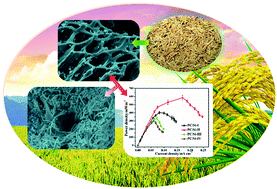当前位置:
X-MOL 学术
›
Sustain. Energy Fuels
›
论文详情
Our official English website, www.x-mol.net, welcomes your
feedback! (Note: you will need to create a separate account there.)
Enhancement of interfacial bioelectrocatalysis in Shewanella microbial fuel cells by a hierarchical porous carbon–silica composite derived from distiller's grains†
Sustainable Energy & Fuels ( IF 5.0 ) Pub Date : 2018-01-02 00:00:00 , DOI: 10.1039/c7se00560a Xiaoshuai Wu 1, 2, 3, 4, 5 , Yan Qiao 1, 2, 3, 4, 5 , Zhuanzhuan Shi 1, 2, 3, 4, 5 , Chang Ming Li 1, 2, 3, 4, 5
Sustainable Energy & Fuels ( IF 5.0 ) Pub Date : 2018-01-02 00:00:00 , DOI: 10.1039/c7se00560a Xiaoshuai Wu 1, 2, 3, 4, 5 , Yan Qiao 1, 2, 3, 4, 5 , Zhuanzhuan Shi 1, 2, 3, 4, 5 , Chang Ming Li 1, 2, 3, 4, 5
Affiliation

|
The microbial fuel cell (MFC) is an attractive green energy source since it can use wastewater and/or organic wastes as fuels to generate electricity. A cost-effective anode material with superior bioelectrocatalysis activity is critical to MFC. In this study, a honeycomb-like hierarchical porous carbon–silica (PC/Si) composite with macropores (2–15 μm) and mesopores (3–4 nm) was derived from distiller's grains via a simple carbonization procedure and used as an anode in a Shewanella putrefaciens CN32 (S. putrefaciens CN32) fuel cell for the first time. The obtained three dimensional scaffold structure with meso pores on the wall provides not only a large surface for bacteria adhesion, but also more active sites for flavin mediated interfacial electron transfer. It is interesting that the siliceous crusts of this PC/Si composite greatly promote the bacteria adhesion as well as a uniform biofilm formation. Accordingly, the PC/Si anode delivers a maximum power density of 580.7 mW m−2 in S. putrefaciens CN32 MFC, which is 4.5-fold higher than that of the conventional carbon cloth anode. Considering the synthesis process of this biomass based carbon material is facile, this PC/Si anode could be very promising when applied for high performance, large scale MFC.
中文翻译:

蒸馏酒颗粒产生的分级多孔碳-二氧化硅复合材料 增强了希瓦氏菌微生物燃料电池的界面生物电催化作用†
微生物燃料电池(MFC)是一种有吸引力的绿色能源,因为它可以使用废水和/或有机废物作为燃料来发电。具有优异的生物电催化活性的具有成本效益的阳极材料对于MFC至关重要。在这项研究中,通过简单的碳化程序从酒糟中获得了具有大孔(2–15μm)和中孔(3–4 nm)的蜂窝状分级多孔碳-二氧化硅(PC / Si)复合材料在Shewanella putrefaciens CN32(腐烂链球菌)中CN32)首次使用燃料电池。所获得的在壁上具有介孔的三维支架结构不仅为细菌粘附提供了较大的表面,而且为黄素介导的界面电子转移提供了更多的活性位点。有趣的是,这种PC / Si复合材料的硅质外壳极大地促进了细菌的粘附以及均匀的生物膜形成。因此,PC / Si的阳极提供580.7毫瓦米的最大功率密度-2在S. putrefaciens CN32 MFC,其比常规的碳布阳极的4.5倍。考虑到这种基于生物质的碳材料的合成过程很容易,这种PC / Si阳极在应用于高性能,大型MFC时可能非常有前途。
更新日期:2018-01-02
中文翻译:

蒸馏酒颗粒产生的分级多孔碳-二氧化硅复合材料 增强了希瓦氏菌微生物燃料电池的界面生物电催化作用†
微生物燃料电池(MFC)是一种有吸引力的绿色能源,因为它可以使用废水和/或有机废物作为燃料来发电。具有优异的生物电催化活性的具有成本效益的阳极材料对于MFC至关重要。在这项研究中,通过简单的碳化程序从酒糟中获得了具有大孔(2–15μm)和中孔(3–4 nm)的蜂窝状分级多孔碳-二氧化硅(PC / Si)复合材料在Shewanella putrefaciens CN32(腐烂链球菌)中CN32)首次使用燃料电池。所获得的在壁上具有介孔的三维支架结构不仅为细菌粘附提供了较大的表面,而且为黄素介导的界面电子转移提供了更多的活性位点。有趣的是,这种PC / Si复合材料的硅质外壳极大地促进了细菌的粘附以及均匀的生物膜形成。因此,PC / Si的阳极提供580.7毫瓦米的最大功率密度-2在S. putrefaciens CN32 MFC,其比常规的碳布阳极的4.5倍。考虑到这种基于生物质的碳材料的合成过程很容易,这种PC / Si阳极在应用于高性能,大型MFC时可能非常有前途。







































 京公网安备 11010802027423号
京公网安备 11010802027423号